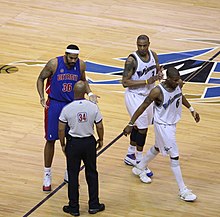User:Kehlannolte
Definition:
[edit]- A player who is dribbling may not put any part of his hand under the ball and (1) carry it from one point to another or (2) bring it to a pause and then continue to dribble again.[1]
The NBA outlines exactly what constitutes a carrying violation during a game, but over the years, NBA fans have seen different installments of this rule, and the frequency of this violation being called.
Background:
[edit]

History of the Rule: James Naismith, creator and founder of the game we know of today as basketball, actually indirectly created the original carrying violation. Naismith implemented twelve foundational rules of basketball with one being, " A player cannot run with the ball. The player must throw it from the spot on which he catches it, allowance to me made for man who catches the ball when running, if he tries to stop." [2]When basketball was first being played, dribbling the ball was not a very popular method of moving the ball around the court, instead the players would preform subsequent short passes between teammates, to advance the ball. For the next fifty years, the carrying violation in the NBA didn't see much discussion, as fans saw the rule being enforced at all times when a player puts their hand under the ball, and continues another dribble.

The 80s and 90s: It wasn't until the early 80s and throughout the 90s where the carrying rule was again put under the spotlight. Argued as the greatest player to ever play in the NBA, Michael Jordan, many fans started to notice that Jordan would often put his hand under the ball and continue dribbling, otherwise known as carrying, without consequence from the officiating team. Fans speculated even further and began assuming that due to the star-power and celebrity status Jordan held, he was the benefactor of "superstar calls". Superstar calls are calls only the biggest name players get, many believing that this is the NBA's way of preserving their status among pop culture. Superstar calls come in all forms, whether its players being allowed to carry the ball more frequently without repercussion, or receiving more fouls called in favor of the superstar player. While the carrying violation problem wasn't necessarily a big issue for fans, as we move towards the turn of the 2020s, the NBA knew they had to do something.
Section II—Dribble (Including Carrying) Running Without Dribbling: A player must dribble while moving with the ball. Boundary Control: A dribbling player stepping out of bounds cannot be the first to touch the ball upon re-entry. Multiple Dribbles: A player cannot start a new dribble after voluntarily ending the previous one. Carrying the Ball: Carrying, or palming, is when a player places a hand underneath the ball and either moves from one point to another or pauses and then resumes dribbling. This is not allowed and is considered the same as running with the ball without dribbling. Legal Dribble Resumption: Dribbling can resume if the ball is lost due to: An attempt at a field goal, if the ball contacts the backboard or rim. An opponent's touch. A pass or fumble that touches the backboard, rim, or another player. Penalty for Dribble Violations: Loss of ball, with the opposing team gaining possession at the nearest sideline spot of the infraction, no closer to the baseline than the foul line extended.
References
[edit]- ^ "RULE NO. 10: Violations and Penalties". official.nba.com. 2018-10-15. Retrieved 2024-04-17.
- ^ "Naismith's Rules". Naismith Basketball Foundation. 2014-03-10. Retrieved 2024-04-17.
Official.NBA.com

